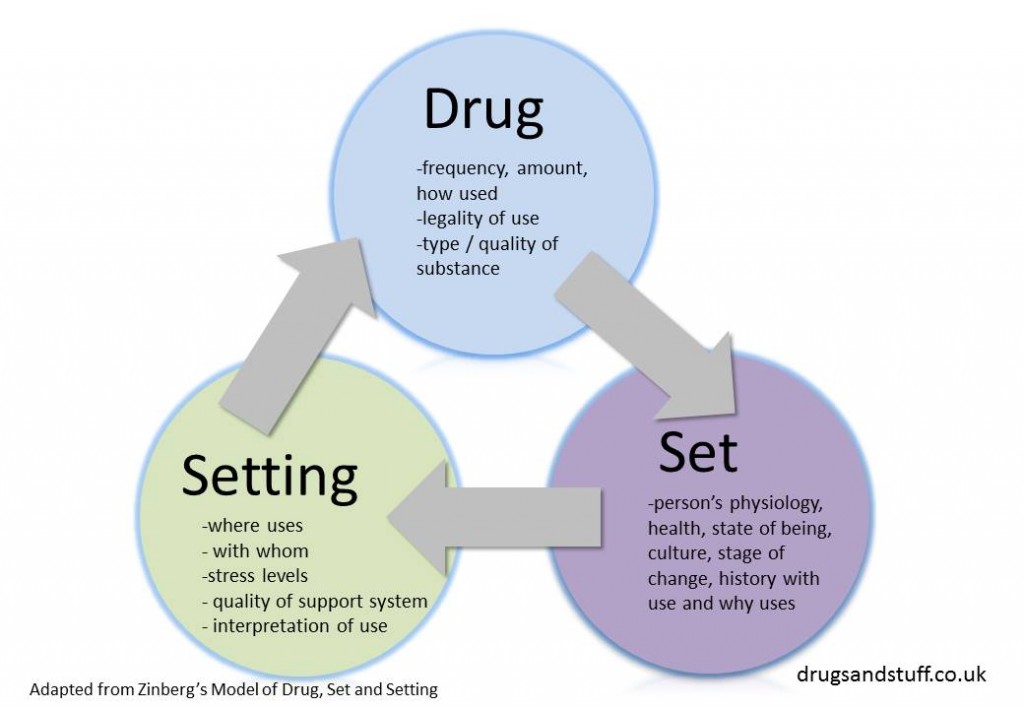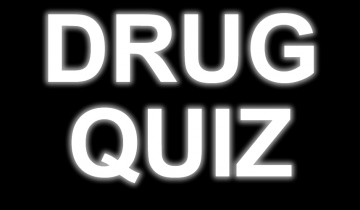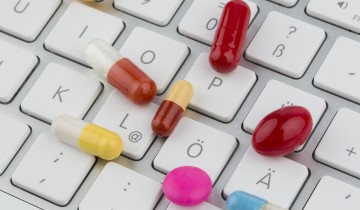Introduction

Some people think everyone who takes drugs will end up dead. Others, and especially some young people, seem to believe that drug use is one big laugh and not that dangerous. Or if it is dangerous, it’s dangerous for someone else.
The truth is somewhere in between. Drug use can never be 100 per cent safe but it is not always as dangerous as many people believe. The dangers of drug use depend on the ‘drug’ used, ‘set’ and ‘setting’.
drug– everything connected with the drug and how it is used.
set– everything connected with the person who is using the drugs.
setting – what the person is doing at the time, where they are, the environment they live in etc.
The basic principal is that drug dangers are the result of interactions between ‘drug’, ‘set’ and ‘setting’.
Drug
All drugs are not all the same. Different drugs have different dangers associated with them.
Some drugs (such as alcohol, heroin and tranquillisers) have a sedative or depressant effect which slow down the way the body and brain function. They can have a numbing effect that produces drowsiness if a lot is taken. Other drugs (such as amphetamine, cocaine, crack and ecstasy) have a stimulant effect giving a rush of energy and making people more alert. A third group of drugs (such as LSD and magic mushrooms and to a lesser extent cannabis and ecstasy) have a hallucinogenic effect. This means they tend to alter the way the user feels, sees, hears, tastes or smells.
Depressant
Depressant drugs like alcohol and heroin can lead to fatal overdose if a lot is taken. They can also affect co-ordination making accidents more likely. Use of some depressant drugs may also lead to physical dependence and withdrawal symptoms.
Stimulants
Drugs that speed up the central nervous system can produce anxiety or panic attacks particularly if taken in large quantities. They can also be particularly dangerous for people who have heart or blood pressure problems.
Hallucinogens
Hallucinogenic drugs sometimes produce very disturbing experiences and may lead to erratic or dangerous behaviour by the user, especially if they are already unstable.
And of course some drugs are legal and others are not. Being arrested and getting a conviction can lead to all sorts of problems.
The dangers of drug use may also depend on:
- How much is taken. The more that is taken the greater the danger. Taking too much of a depressant drug can lead to a fatal overdose. Taking a large dose of a stimulant drug can lead to panic attacks or even in extreme cases, psychotic behaviour (where all sense of reality is lost). Taking a large dose of a hallucinogenic drug may lead to disturbing experiences. Taking a high dose of many drugs can lead to a lack of co-ordination and increase the likelihood of accidents.
- How often the drug is taken. The more often a drug is taken, the greater the risks to your health, particularly if the body hasn’t had time to recover. With some drugs a tolerance can develop and more needs to be taken in order to keep getting an effect. If heavy, frequent use is followed by a period of non-use tolerance levels drop. Taking the same amount of drug needed with high tolerance levels can bring on an overdose, especially with drugs like heroin.
- Other things in drugs (adulterants). Many illegal drugs, especially in powder or pill form, have other drugs or substances mixed in with them. These can change the effect of the drugs and contribute to dangers.
- Mixing drugs. Combining drugs can produce unpredictable and sometimes dangerous effects. In particular, mixtures of depressant drugs can be very dangerous. Many users have reported drug overdoses involving mixtures of alcohol and tranquillisers or opiates.
- How a drug is taken. The method of use will influence the effect the drug has and its possible dangers. Injecting drugs has a very quick and intense effect. Snorting or inhaling drugs can also have a quick but slightly less intensive effect. Smoking drugs produces a slower, more subtle effect sometimes. The slowest effect of all is eating or drinking a drug.
Drug dangers also vary with the method used to take them:
- Injecting is particularly risky because it is difficult to know how much is being taken. Injection also carries the risk of infection by blood borne diseases if any injecting equipment is shared. A high profile has been given to HIV, but there are also risks from Hepatitis B and C, both potentially very serious blood borne diseases.
- Eating or drinking a drug can be risky if people take a lot in one go. The effects tend to be slow but once they come on it is too late to do anything about it. Examples are drinking too much alcohol in a short space of time or eating a lump of cannabis. In such cases people can suddenly feel very drunk or stoned and become very disorientated.
- Snorting drugs like amphetamine or cocaine powder up the nose on a regular basis can lead to damage to the nasal membranes although this risk may sometimes have been exaggerated.
- There are more or less dangerous ways of inhaling solvents such as glues, gases and aerosols. Squirting solvents into a large plastic bag and then placing the bag over the head has lead to death by suffocation. Squirting aerosols or butane straight down the throat has lead to deaths through freezing of the airways. Squirting onto a rag or small bag then inhaling is not as dangerous, but of course still dangerous.
- Smoking a drug is a relatively less dangerous method of use although regular smoking can damage the respiratory system especially if the drug is smoked with tobacco, as is often the case with cannabis.
Set
The effects and dangers of drugs are influenced by many things. Personal factors involving the person who is using the drugs can be just as important as the drugs being used.
The drug experience and the expectations of the user are important. Many young people experimenting with drugs for the first time will be unsure about what to do or what to expect. This ignorance and lack of experience can itself be dangerous.
The mental or psychological state of the drug user is very important. The mood people are in when they take drugs influences the effects and dangers of drug use. If they are anxious, depressed or unstable they are more likely to have disturbing experiences when using drugs. They can become more anxious and disorientated, possibly aggressive, ‘freak out’ and do crazy things or take too much etc. As a general rule someone who is happy and stable is more likely to use more carefully and not be so badly affected.
Other things about the person which may effect drug dangers include:
- If they have physical health problems like heart disease, high blood pressure, epilepsy, diabetes, asthma or liver problems, drug use could be more dangerous and possibly make their health problem worse.
- The drug users energy levels at the time of consuming drugs can also be important. If they are tired at the time of use then it may have a different or more extreme effect than if they are fresh and full of energy.
- If the user has a low body weight the same amount of drugs may effect them more than heavier people. Also people who have eating disorders like anorexia or bulimia can find that drug use makes their eating difficulties even worse.
- Men and women can experience drugs in different ways. This is both because of their different physical make up and the different way people view male and female drug use. On average women are of smaller body weight than men, have smaller livers as a proportion of body weight and a greater proportion of body fat. This means that, generally speaking, the same amount of drugs will have a greater effect on a woman than on a man. Obviously this will not apply with a much larger than average woman or a much smaller than average man.
- The effects and risks of drug use are also influenced by attitudes towards men and women taking drugs. Women are often seen as doubly bad if they take drugs. Male drug use is often seen as more acceptable than that of women and mothers, in particular, come in for a lot of criticism if they use drugs. Male drug users who are parents are not usually seen in the same sort of way. Sexism can also affect the experience of drug use and drug risks.
Setting
The place where drugs are used and what people are doing at the time can influence how dangerous it is. For example, some young people take drugs in out-of-the-way places that are particularly dangerous like canal banks, near motorways, in derelict buildings etc. Accidents are much more likely in these places, especially if the user is intoxicated. Also if anything does go wrong, it is unlikely help will be at hand or that an ambulance could easily be called.
Even if the setting is not in itself inherently dangerous there may be other types of risks associated with the place of use. Using or taking drugs into school has led to substantial numbers of young people being expelled from school with drastic effects on their future careers.
Driving a car or bicycle or operating machinery while on drugs, will greatly increase the risks of accidents.
Drug use can lower inhibitions, increasing the likelihood of sexual encounters. Safer sex – e.g. by using condoms – will be much more difficult if the person concerned is intoxicated. The risks of unwanted pregnancy, HIV and other sexually transmitted infections could be increased if people have sex while high on alcohol or drugs. Surveys have found that many young people have sexual encounters while under the influence of drugs, particularly alcohol and/or cannabis.
Another setting danger is that of people over-exerting themselves when using ecstasy. Ecstasy gives a buzz of energy and is often used in clubs while dancing non-stop for long periods. In some situations people have danced for hours without a break in hot, crowded environments. They run the risk of becoming dehydrated and getting heat exhaustion. In some cases this can be very dangerous and it has led to a number of deaths. “Chillin out” having a break from dancing, cooling off and sipping or drinking water or fruit juice at regular intervals (not alcohol as it further dehydrates the user) – reduces these risks.
Conclusion
There are many possible risks and dangers involved when using drugs. To fully understand potential risks and dangers you will need to think about drug, set and setting.
In addition people may experience people problems with drug use because of other people’s perceptions and responses to them. Examples include conflict in family and other personal relationships, getting thrown out of school/ college or work, getting a criminal record, getting into debt to pay for drugs, violence associated with drug dealing etc.
This explanation is from www.drugscope.org.uk
Set and setting describes the context for psychoactive and particularly psychedelic drug experiences: one’s mindset and the setting in which the user has the experience. This is especially relevant for psychedelic or hallucinogenic experiences. The term was coined by Norman Zinberg, and became widely accepted by researchers in psychedelic psychotherapy.
http://www.psychedelic-library.org/zinberg.htm
Read about why do people use drugs.



